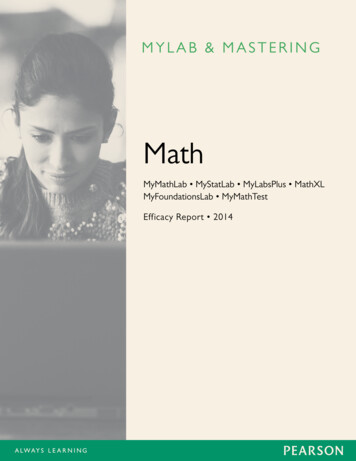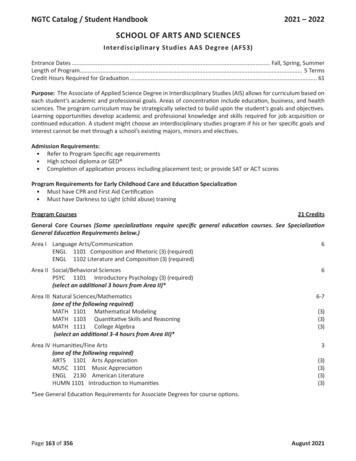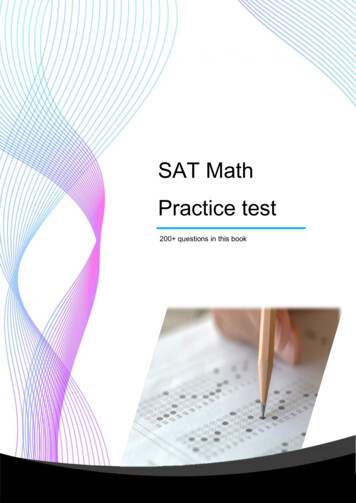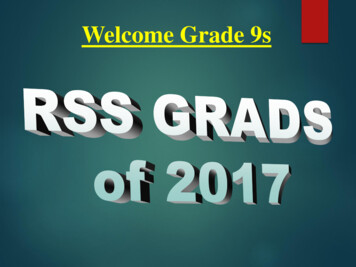
Transcription
MYLAB & MASTERINGMathMyMathLab MyStatLab MyLabsPlus MathXLMyFoundationsLab MyMathTestEfficacy Report 2014
Math Efficacy ReportEdited by Michelle D. Speckler 2014 PearsonMyMathLab, MyStatLab, MyLabsPlus, MathXL, MyFoundationsLab, and MyMathTest and are registered trademarks of Pearson.www.pearsonhighered.com
Welcome LetterWelcome LetterWe are delighted to share the seventh issue of the Math Efficacy Report (formerly,Making the Grade). Both Pearson and the mathematics community have come a longway since our first issue in 2005—the content and structure of this report directly reflectboth these enormous strides and today’s rapidly evolving higher education landscape.At Pearson, we define efficacy as a measurable impact on improving someone’s lifethrough learning. We are embarking on a global education initiative and dedicatingourselves to the pursuit of efficacy and improved learner outcomes.On the following pages you’ll find exemplar, data-driven case studies from two- andfour-year institutions, as well as fully online implementations, plus the following featurearticles inspired by the most talked about topics in higher ed mathematics: Studies on Long-Term Success: 10 Years of Sustained Positive Learning Outcomes Personalized and Adaptive Learning: Successful Implementation Models College–High School Partnerships: Dual-Enrollment and Bridge Programs Changing the Equation: Observed Best Practices Getting Started: Planning Your MyMathLab ImplementationVisit the PearsonResults Librarywww.pearsonmylab.com/resultsLooking for more case studies? Visit the Pearson Results Library, an online repositoryof more than 400 data-driven case studies quantifying the positive impact of MyLaband Mastering programs on learning outcomes, retention, and subsequent success.This comprehensive database is cross-referenced by institution type, course format,state/province, and more; and is easy to access at www.pearsonmylab.com/results.We extend our deepest gratitude to each contributing instructor. Each case study wassubmitted voluntarily and without compensation; each instructor submitted his or herstudy and remained available for follow-up interviews. Their efforts are invaluable.We invite you to contact us with any questions about this report, as well as to share yourideas, your best practices, or your results in our next edition. Pearson is happy to provideboth consultation and data collection tools to help you measure the impact of a MyLab &Mastering product in your course.We look forward to hearing from you.Traci Simons, Senior Efficacy Results Managertraci.simons@pearson.comJohn Tweeddale, Senior Vice President, Efficacy and stering.com 1
Math Efficacy ReportTable of ContentsPearson Standards for Efficacy Research. 3Case Studies. 4Four YearEast Carolina University, NC. 4University of Louisville, KY . 6University of South Alabama, AL. 8University of South Florida, FL. 10Two YearChattanooga State Community College, TN. 12East Los Angeles College, CA. 14Guilford Technical Community College, NC. 16Reading Area Community College, PA. 18South Arkansas Community College, AR. 20OnlineFlorida State College at Jacksonville, FL. 22St. Philip’s College, TX. 24Studies on Long-Term Success:10 Years of Sustained Positive Learning Outcomes. 26Personalized and Adaptive Learning:Successful Implementation Models. 34College–High School Partnerships:Dual-Enrollment and Bridge Programs. 36Changing the Equation: Observed Best Practices. 39Getting Started: Planning Your MyMathLab Implementation. 43Glossary. 45Conclusion. 46Pearson Results Library: Mathematics and Statistics Case Studies. 47Index: Institutions Included in this Report. 512 pearsonmylabandmastering.com
Pearson Standards for Efficacy ResearchPearson Standards for Efficacy ResearchAt Pearson, we believe that learning is a life-changing opportunity, and that education should have a measurable, provenimpact on learners’ lives. It’s what Pearson’s efficacy programand tools are all about. Pearson is putting the pursuit of efficacyand learning outcomes at the center of its global educationstrategy—you can read more at efficacy.pearson.com. Whenwe publish our annual report in 2018, we will, in a rigorous andexternally audited way, report on the progress we have madein improving learner outcomes.Why Pearson Is Interested in Efficacy StudiesLearner outcomes have always been important to Pearson—our fundamental purpose is to help people make progress intheir lives through learning. We already have many examplesof products that can demonstrate their impact on learners,but going forward our aim is to ensure that every action, everydecision, every process, and every investment we make will bedriven by a clear sense and understanding of how it will makea measurable impact on learning outcomes.It is increasingly possible to determine what works and whatdoesn’t in education, just as in healthcare. Growing researchand evidence, advancements in technology and our enhancedability to harness the power of data offers a huge opportunityto drive improvements in learning. Pearson, as the world’slargest learning company, has both the responsibility and thepotential to pursue and lead this conversation. Toward thatgoal, we actively seek out educators who wish to exploreeducational research questions and investigate the efficacy ofour digital solutions and services.staff with detailed reports on the quality of our online content,and (3) advise our software engineers of new methodologiesfor collecting and processing student learning data within ourdigital solutions.How Pearson and Instructors Work TogetherEvery research project is unique. The process takes time—generally a semester or longer. Instructors interested inconducting studies should expect an interactive and rewardingpartnership.How Pearson Can Help Instructors Get StartedPearson can provide templates, guidelines, questionnaires,checklists, and samples on course redesign, efficacy studies,data collection, and more. To maintain objectivity, Pearson doesnot offer compensation for participation in efficacy studies.Research StandardsPearson adheres to the Software & Information IndustryAssociation guidelines for evaluation of educational technologyproducts. The key guidelines are: Ask the right question Support the implementation of the productor service Plan a study of sufficient size and durationto demonstrate an effect Plan for plausible causal claimsPearson’s Efficacy Research Team Avoid (the appearance of) conflicts of interestOur global efficacy team is headed by Sir Michael Barber, aleading authority on education systems and reform. TheNorth American Efficacy & Quality team includes more than30 professionals dedicated to helping educators deliver desiredlearner outcomes. Provide a comprehensive and detailed researchreport Make the research findings widely available Accurately translate research for customersWe provide practical advice about tracking and analyzingstudent data as part of the implementation of a Pearson digitalsolution. Experts in psychometrics, educational statistics, andjournal publications are available to support instructors whowant to (1) conduct efficacy studies, (2) provide our editorialContact traci.simons@pearson.com for more information.pearsonmylabandmastering 3
EAST CAROLINA UNIVERSITYGreenville, NCProduct Name College Algebra, MyMathLab, TrigstedCourse Name College AlgebratCourse Format Hybrid: open labKey ResultsAfter redesigning College Algebra using MyMathLab in the National Center for AcademicTransformation’s Emporium model, combined fall and spring success rates increased an averageof 11.8 percentage points—from 60 percent to 71.8 percent.Materials in UseTrigsted MyMathLab College Algebra, Kirk TrigstedImplementationThe College Algebra course at East Carolina University (ECU)suffered from low passing rates, and budgetary concernsprompted the university to redesign the course to address bothissues.The course serves approximately 3,000 students a year.These large enrollments meant that before the redesign,several instructors taught a large number of sections, with verylittle consistency among the sections. Although all instructorsassigned the same homework problems and gave a commonfinal, some instructors chose to give quizzes, some tookattendance, some offered test reviews, some used coursepacks, and so on.Course DesignECU modeled their redesigned College Algebra courseafter Louisiana State University’s College Algebra course.To ease into the redesign, ECU required all instructors to useMyMathLab for one year. Instructors used identical coursesyllabuses, class notes, and MyMathLab assignments. Allhomework and quizzes were completed online and eachteacher gave his or her own in-class test. During fall 2011,many of the classes had 100–120 students. That same semester,ECU piloted the redesign in one section.4 pearsonmylabandmastering.comIn fall 2012, ECU launched its College Algebra Virtual Environment (CAVE) math lab with 120 computers. The lab is openMonday through Thursday from 9am to 9pm and Friday from9am to 5pm.In the redesigned format, students spend one hour per weekin class with an instructor, and are required to spend threehours per week in the lab working on MyMathLab homework,quizzes, and tests. They can also use lab time to obtain one-onone instruction. There is always at least one instructor in thelab and more during peak hours, in addition to undergraduatetutors, graduate students, and a few volunteers.Assessments45 percentMyMathLab tests25 percentMyMathLab final exam10 percentMyMathLab quizzes10 percentMyMathLab homework5 percentClass participation5 percentLab participationUse of MyMathLab contributes 90 percent to a student’s finalcourse grade.
East Carolina University“Math is not a spectator sport. An instructor can stand up and do the problems all day long,but until students practice it, they’re not going to get it. MyMathLab forces students to do math,which is what they need to do to see success.”The Student ExperienceAt first, most students didn’t like the learning curve associatedwith MyMathLab and the course redesign. Faculty listened totheir concerns and made adjustments.Percentage of %20%0%FallBefore Redesign(Fall 2007–Spring 2011)SpringHybrid(Fall 2011–Spring 2012)After Redesign with MyMathLab(Fall 2012–Spring 2013)Figure 1. College Algebra Average ABC Rates by Fall and Spring, beforeRedesign (Fall 2007–Spring 2011), during the Hybrid Format (Fall 2011–Spring2012), and after Redesign (Fall 2013–Spring 2013)Results and DataPrior to redesign, College Algebra average fall ABC rates wereas low as 66.8 percent; average spring ABC rates were as lowas 53.2 percent. After redesign with MyMathLab, fall ABC ratesincreased 5.9 percentage points to 72.7 percent; spring ABCsuccess rates increased 17.7 percentage points to 70.9 (figure 1).For example, better students who often finished their workbefore the three hours of lab time per week were up would runout of work to do and become frustrated. Faculty respondedby allowing students who had a 95 average after the first examand a 100 average on all their assignments for the week to beexempt from the three-hour rule that week.Students appreciate the help and flexibility that MyMathLabprovides: “The CAVE gave me easy access to instructors forany questions I had, including computer problems andhomework. Being allowed to take the quizzes up to10 times helped my grade and helped me learn.” “The online assignments walking me through theproblems and helped me understand them.” “Having instructors in the math lab is a good resourcefor when we don’t understand the material.”ConclusionEast Carolina University is seeing significant positive results in ashort amount of time. With the data they’ve gathered thus far,the math department plans to continue modifying the programto include personalized homework assignments and a newcoursepack that requires students to read the e-text prior toattending class.Submitted by Cathy Wilkerson, Lab Directorand Mathematics Instructor (retired) andApril Church, Teaching Instructor and CAVE Director/Math 1065 Course CoordinatorEast Carolina Universitypearsonmylabandmastering 5
UNIVERSITY OF LOUISVILLELouisville, KYProduct Name MyMathLabCourse Name Engineering Analysis 1 (Calculus 1)tCourse Format Hybrid: face-to-face and online on tablets in classKey ResultsFrequent low-stakes assessments in MyMathLab in an ongoing calculus redesign is resultingin consistent course delivery across sections and semesters, plus increased opportunities formultimodal learning and mastery of course material.Materials in UseCustom text derived from Thomas’ Calculus by Weir, Haas,Giordano; Fundamentals of Differential Equations by Nagle, Saff,Snider; and Precalculus by BlitzerImplementationUniversity of Louisville engineering students are requiredto take a calculus sequence from the J.B. Speed School ofEngineering’s Department of Engineering Fundamentals.Engineering Analysis 1, the first course in the sequence offersan in-depth understanding of extensive problem solving indifferential and integral calculus.Class meets five times a week: Monday, Wednesday, and Fridayfor 50 minutes; Tuesday and Thursday for 75 minutes.The implementation started in 2012 by transitioning frompaper-and-pencil homework assignments to custom-createdMyMathLab homework assignments managed by MyMathLab’scoordinator course feature. Students have unlimited attemptson homework and all learning aids are available to them. Theymay continue to work on the homework after the due datebut are assessed a two percent penalty per day. Each unit hasa single set of homework problems.The department recently began developing videos to replaceparts of the traditional class lecture. For each unit, somematerial is covered in videos that students watch outside ofclass, thereby reducing the total number of class meeting hoursper week by 40 minutes (Tuesday classes meet for 40 minutes).This material is not covered during lecture—it is the students’responsibility to watch the videos, which they access asMyMathLab media assignments within their homeworkassignments. Video assignments have a due date but may bereviewed later.6 pearsonmylabandmastering.comOnce homework fully shifted to MyMathLab, the departmentbegan using MyMathLab for formal testing. Currently there isa MyMathLab test for each unit in the course. Tests are proctored and available for two days. Some sections have requiredstudents to earn at least 70 percent on the homework in orderto take the associated unit test. Students have 40 minutes tocomplete each test, have one attempt, and no learning aidsare available. The department uses MyMathLab’s LockdownBrowser feature to ensure security.Other ways to use MyMathLab for formal assessment are beingevaluated, including unannounced, in-class pop-quizzes and aproctored, final exam in advance of the paper-and-pencil finalexam.The department uses MyMathLab’s prerequisites feature toensure mastery—students are required to earn at least 70percent before moving to the next assignment. It also employsquestion pooling in quizzes and tests to help differentiate thequestions each student receives.Assessments55 percentExams(13, paper-and-pencil, each covers two units)25 percentFinal exam (paper-and-pencil)15 percentMyMathLab tests (13, each covers one unit)5 percentMyMathLab homeworkUse of MyMathLab contributes 20 percent to each student’sfinal course grade.
University of LouisvilleThe Student ExperienceAverage Final Exam Score100%80%72.3%65.5%65.3%60%40%20%0%Fall 2010Fall 2011Fall 2012No MyMathLab50% of homeworkin MyMathLabHomework andquizzes in MyMathLabFigure 1. Average Final Exam Scores as Use of MyMathLab Increased,Fall 2010–Fall 2012 (n 736)Results and DataA primary benefit of the redesign lies in the data-collectioncapability of MyMathLab. Item analysis of MyMathLab unittests helps identify areas of difficulty, often confirming whatinstructors have long suspected. Many instructors use thisfeature to prepare for review days. “A benefit that thedepartment hopes to soon realize is creation of assessmentsin MyMathLab that can be reused each semester and comparedacross semesters,” says Jeffrey Hieb, assistant professor ofEngineering Fundamentals.Hieb reports that the department has realized real benefitswithout a dip in student performance. After tracking andanalyzing the average final exam scores of three cohortsthroughout their calculus sequences, he found no significantnegative impact (figure 1). “It may seem counter-intuitive tobe pleased with ‘doing no harm’ to students, but in a shortamount of time we have made substantial changes to thedelivery of our calculus courses that saved money and time,”says Hieb. “‘Doing no harm’ is a victory for us at this point.Students now have more accessible, high-quality resources attheir disposal. Our latest objectives include adding componentsto the course that help students understand how to make useof these resources, and to use MyMathLab to hold studentsaccountable for gaining proficiency on specific topics beforetaking their paper tests.”In addition, because student graders are no longer neededfor homework and quizzes, the school has decreased itsinstructional costs.Hieb first employed MyMathLab to replace the paper homework assignments for his calculus III class. He recalls howpositive students’ reactions were to the change, “Students likedthe fact that they could practice the homework as many timesas they chose. Several asked if MyMathLab would be availablenext semester.”Since scaling the implementation, Hieb and his colleagues haverealized that students’ attitudes toward their assignments arecritical to their success. “When students don’t make the connection between the homework or quiz and the exam, theydon’t take the results seriously and they don’t view their gradeas an indicator of their comprehension, when in reality, it is agood indicator,” says Hieb. “One of the areas we would like toimprove is getting students to see the importance of taking thequiz results and using that to direct their learning. MyMathLab’sStudy Plan is one way to do this.”ConclusionThe Engineering Fundamentals Department has learned avariety of lessons, including the importance of change. “Youcan’t just take what you used to do and replace it withMyMathLab,” says Hieb. “You must change the way you’vethought about your course and use MyMathLab to its fullestpotential. That’s why at the onset we invested time writingour own problems in MyMathLab—we wanted to ensure thatstudents were receiving the engineering application problemswe wanted them to have. They are receiving the same coursestudents took in 2010, just more automated and with gradeinformation more readily available. In addition, instructors arespending more time teaching and less time grading, and thedepartment is realizing cost savings.”The department is pleased with the results they’ve seensince implementing MyMathLab—and they realize they’re notfinished yet. “We’ve got the homework portion figured out,”says Heib. “Now it’s time to get some more mileage from thetesting.” To that end, Hieb plans to employ the PersonalizedHomework feature in MyMathLab so that students have theopportunity to take the online exams, remediate, and showimprovement on the paper exams. The department also hasbegun tracking and measuring the specific cost and time savings.Submitted by Jeffrey Hieb, Ph.D., Assistant ProfessorDepartment of Engineering FundamentalsUniversity of Louisvillepearsonmylabandmastering.com 7
UNIVERSITY OF SOUTH ALABAMAMobile, ALProduct Name MyLabsPlusCourse Name Intermediate AlgebratCourse Format Hybrid: meets two times per week in lecture and lab 100 additional minutes per week in labKey ResultsAfter implementing a MyLabsPlus-supported hybrid format, student success rates increasedby 29 percent.Materials in UseBeginning and Intermediate Algebra, Martin-GayImplementationIntermediate Algebra is a three-credit-hour course thatsatisfies the math requirements for conditional freshmen withan appropriate math placement score (60–69) or studentswho place into it with a Math ACT of 19–21 and need to satisfythe prerequisite for Precalculus Algebra.The class meets two times per week with split time betweenlecture and the Math Technology Lab. Students are requiredto spend an additional 100 minutes per week in the math labworking on homework or taking quizzes and tests.Homework assignments are completed in MyLabsPlus at home,in class, or in open lab, and can be repeated an infinite numberof times before the due date. The last submitted answer is usedfor grading purposes.Students must score at least 90 percent on the homeworkassignments in order to take the associated MyLabsPlus quizzes.They take the quizzes in the lab and must complete them toa minimum of 70 percent by the assigned date. Students mayattempt quizzes up to seven times, and the highest score isrecorded. They must score at least 70 percent on the quizzesin order to open the associated MyLabsPlus test. Students whodo not achieve 70 percent mastery after taking a quiz seventimes receive mandatory instructor intervention. Students whodo not score at least 90 percent on the homework earn zeropercent on the associated quiz.8 pearsonmylabandmastering.comAssessments75 percentMyLabsPlus tests (four a final)Option A: All tests count 15 percent.Option B: Drop lowest test score,final counts 30 percent.10 percentParticipation/attendance8 percentMyLabsPlus quizzes7 percentMyLabsPlus homeworkUse of MyLabsPlus contributes 90 percent to each student’sfinal course grade.“We want students to be engagedand to know that they have a facultywho truly cares about their success.”Results and DataThe school has attained its redesign goal of increasing Intermedate Algebra success rates. The success rate has steadilyrisen from 49 percent in fall 2010, the first semester of theMyLabsPlus implementation, to 63 percent in fall 2013 (figure 1).In spring 2014, the faculty replaced the cumulative homeworkwith a 25-question pretest that more closely resembles theexam and does not include student learning aids. Test 1 resultsshowed a positive improvement over previous semesters:60 percent of students who attempted the test received anA—a 22 percent increase over Test 1 results in the previoussemester (figure 2).
University of South Alabama“I never learned math as quickly as I did with this software.It took me from being a C student in math to an A entage of StudentsPercentage of Students100%80%60%60%49%40%30% 28%20%17%12%20%9%9%21%3%0%A0%Fall 2010/Spring 2011Fall 2011/Spring 2012Fall 2012/Spring 2013Fall 2013/Spring 2014BCFall 2013FDid NotAttemptSpring 2014Figure 1. Intermediate Algebra Success Rates, Fall 2010–Spring 2014 (n 2,898)Figure 2. Intermediate Algebra Test 1 Grade Distribution before and afterPractice Test Implementation, Fall 2013–Spring 2014 (n 550)The Student ExperienceConclusionThe majority of students surveyed about the implementationreport having a positive experience with MyLabsPlus. Studentsurveys indicated that students agreed or strongly agreed withthe following statements:University of South Alabama’s redesign taught the school’sfaculty the importance of never giving up. In 2010, the mathdepartment redesigned from a face-to-face, lecture format toa full emporium model that was completely self-paced with anopen lab and no hour requirements. When the results were notsatisfactory, the course was adjusted to a full mastery-basedmodel. When the results were still not as desired, the schoolmodified the redesign once again by adding test deadlines andimplementing clickers and class activities in lecture. Today theschool believes it has “hit the mark,” and its results show thatto be true. “We want students to be engaged and to know thatthey have a faculty who truly cares about their success,” saysLeslie Whiston, instructor.92%MyLabsPlus gave me the opportunityto work extra problems, which helped meunderstand the material better.65%Overall the computer software used in thecourse is good/excellent.63%MyLabsPlus helped me gain confidencein problem-solving.60%Because of MyLabPlus, I was able to obtaina higher grade than in a traditional classroom.55%The video lectures helped me to learn concepts.Submitted by Leslie Whiston, Interim Cochair,Department of Developmental StudiesUniversity of South Alabamapearsonmylabandmastering.com 9
UNIVERSITY OF SOUTH FLORIDATampa, FLProduct Name MyLabsPlusCourse Name College AlgebratCourse Format Emporium: open lab face-to-face discussion, fixed due datesKey ResultsAfter redesigning College Algebra using MyLabsPlus in an emporium model, success (ABC) ratesincreased nearly 12 percent and final exam pass rates increased 21 percent.Materials in UsePrecalculus: A Unit Circle Approach, Ratti and McWatersImplementationCollege Algebra is a prerequisite for several of USF’s science,technology, engineering, and mathematics programs, but in thetraditional model, the average success rate for the course wasonly 65 percent (2007–2010). Redesign was one way the schoolsought to increase student outcomes.The redesigned course, based on the National Center forAcademic Transformation’s Emporium model, promotesstudent engagement in the learning process. Each week,students are required to attend a large discussion sessionand spend at least three hours in the computer lab usingMyLabsPlus. In the discussion session, students use a personalresponse system (clickers) to collaborate and respond to questions posed by the instructor. In the lab, they are encouragedto use MyLabsPlus’s interactive learning resources, includingtutorials with immediate feedback, videos, and animated slidepresentations. In addition, graduate teaching assistants and mathtutors are available for one-on-one assistance.All tests, the final exam, homework, and course content quizzesare completed in MyLabsPlus. Students are given three attemptson each homework assignment, and they must score a minimumof 70 percent in order to access that section’s quiz. Students arethen given one attempt on the timed quiz. Students may earn upto three possible extra credit points by completing MyLabsPlusStudy Plans.10 pearsonmylabandmastering.com“The average final exam pass rate forthe redesigned classes was 11.8 percentagepoints higher than the rate for the traditionalclasses—a full letter grade.”Assessments45 percentMyLabsPlus tests (3)25 percentMyLabsPlus final exam10 percentMyLabsPlus quiz8 percentMyLabsPlus homework6 percentLab attendance4 percentDiscussion session clicker grade1 percentPrerequisite skills assessment0.5 percentHow to enter answers quiz0.5 percentLab orientation quizUse of MyLabsPlus contributes 88 percent to each student’sfinal course grade.
University of South Florida100%85.4%80%78.6%76.9%82.0%Percentage of StudentsPercentage of 8.3%56.8%57.5%56.0%40%20%0%Spring 2011Before Redesign(Fall 2007–2010)Fall 2011CombinedSpring 2011After Redesign with MyLabsPlusFall 2011Before Redesign(Fall 2007–2010)CombinedAfter Redesign with MyLabsPlusFigure 1. College Algebra Average Success (ABC) Rates before and afterRedesign, Fall 2007–Fall 2011 (n 1,848)Figure 2. College Algebra Average Final Exam Pass Rates before and afterRedesign, Fall 2007–Fall 2011 (n 1,629)Results and Data “Being given another chance to get it right in homeworkand quizzes was a great motivation to get the best gradeI could. It encouraged me to learn the material, ratherthan forget about it after I got it wrong the first time.” Final exam pass rates also increased: for spring and fall 2011,the average final exam pass rate for the redesigned classes was11.8 percentage points higher than the rate for the traditionalclasses—a full letter grade (figure 2).“I think what has helped me the most in this class is thevideo examples on how to solve the problems. I am avisual learner so to see an actual person working outthe problem helps me understand the concept and stepsbetter.” “The most helpful study tool was doing the Study Plansbefore each test along with the practice tests.”The Student Experience “The practice tests helped me the most because theygave me example problems that were similar to thosethat were on the actual exam.”The redesigned classes for spring and fall 2011 had higheraverage student success rates than did the traditional classes:the averag
College Algebra Average ABC Rates by Fall and Spring, before Redesign (Fall 2007-Spring 2011), during the Hybrid Format (Fall 2011-Spring 2012), and after Redesign (Fall 2013-Spring 2013)











